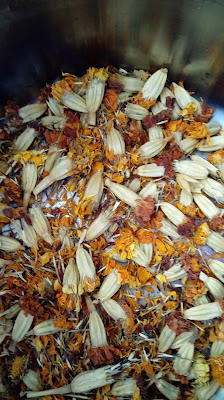 |
| Natural Dyeing: Results from a steamed bundle |
I've always been interested in dyeing my own materials and since school I've experimented with colouring the cloth I use in my art. I've also always liked the idea of natural dyeing and have done bits and pieces but I was always a bit overwhelmed by it and worried about using the right mordants on the right fibres and all the many permutations out there. Last year I treated myself to India Flint's book 'Eco Colour' and I was really inspired by her textiles and her 'try it and see' approach. Her advice is very practical and it's inspired me to stop worrying about having exactly the right quantities/mordants/tools and so on and to just give it a go.
 |
| Solar Dyeing: Jar of water, rusty nail and random leaves and twigs |
 |
| Solar Dyeing: Jar of water, rusty nail and random leaves and twigs |
 |
| Solar Dyeing: Jar of water, rusty nail and random leaves and twigs |
There is a lot of interest in natural dyeing at the moment; along with crafts of all sorts it is seeing a resurgence of interest as people look for ways of reconnecting with the natural world and with using our hands in our increasingly technological and digital world. One of the things I think is great is that a lot of what I've learnt about natural dyeing has been online, marrying the best of both worlds.
 |
| Dried Marigolds collected last year, boiled up with frozen marigolds (also collected last year) to make a dye bath |
 |
| Fabric and threads in with the marigolds |
 |
| Simmering the marigolds |
Another reason for shying away from natural dyeing was that I wasn't aware of which plants to use to get the colours I wanted (you can get an awful lot of yellows from plants, not a colour I use a lot of) and I wasn't confident about the colour fastness. As my work has grown and developed these concerns have become less important and my knowledge of plant dyes has grown through reading about them. I'm now more willing to embrace chance in my work and I'm not so worried if the work changes over time, I see this as part of it's evolution.
 |
| Fabric dyed with marigolds drying outside |
 |
| Fabric and threads dyed with marigolds |
I've also become increasingly concerned about the environmental impact of my work. I've always been interested in green issues and have tried to 'be green' as much as possible. Using natural dyes is another step towards living a more sustainable and ecologically sound life. It also gives me a great excuse to spend more time growing things and going out and about collecting things (in an environmentally conscious way, I only collect if there is an abundance of it and it's a common plant and I never take more than two or three leaves from each plant.)
 |
| Black beans: Soaked to create a dye |
 |
| Fabric in the black bean dye bath |
 |
| Colours from black beans |
With all this in mind I've been doing lots of natural dyeing recently. I've adopted the 'give it a go' mentality so rather than using a plant to create a specific colour I'll use a plant to see what happens. By adopting this highly unscientific approach I've created a range of colours that I have no idea how to repeat again, which is part of their charm. I've been experimenting with solar dyeing (stick stuff in a jar in the sun and leave it for a month) steaming (wrap fabric and leaves into a bundle, steam for half an hour, see what's happened) and more traditional dyeing; making up a dye-bath of plants and immersing fabric in it.
 |
| Fresh out of the black bean dye bath, fades to blue and grey |
 |
| Solar dye jars |
 |
| Solar dye jar |
It's really exciting colouring fabric this way, it's unpredictable and the subtle variations add a character hard to achieve with other dyes. It also requires patience, making me slow down and appreciate and think about the fabric and the colour and the work I'm creating with it.
 |
| Leaves laid onto cloth, ready to be bundled and steamed |
 |
| Steaming the fabric bundle |
I'd love to know more about your steamer set-up. Do you just use a bit of water under an accordion steamer like doing broccoli?
ReplyDeleteYes, it's very low tech but also very effective!
Delete